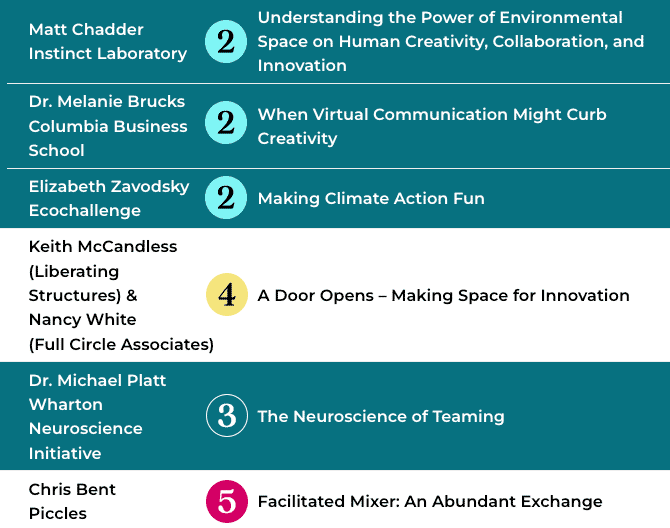Happy Friday {{first_name|friend}}!
We announced our "engaging" upcoming event earlier this week. Today, I want to clarify what that means.
BLUF
The Problem: "Engaging" has multiple meanings.
Participants will complain that an event wasn't engaging. Organizers promise to deliver engaging events.
But are they really talking about the same thing?Participants Deserve Clearer Expectations
When someone says an event will be "engaging", they could mean anything from "Come listen to an interesting discussion," to "Climb a tree and share your deepest fears with your boss."
People opting in to an experience deserve to know what they're signing up for.
Proposed Solution: The Engagement Decoder
We propose a simple rating scale for public events and conferences.
The Goal: make it easy to see at a glance what kind of engagement each session requires.
Engagement in Business Meetings vs Public Events
I'm about 20 years into my deep-dive on all things team collaboration and meetings, so when I say I'd be rich if I had a dime for every time someone asked me how they could make meetings "more engaging," know that I mean rich 🤑 . Like, seriously, sooo much moola.
When asked this question early in my journey, I'd rattle off some obvious tips – Ask questions! Use the chat! Take turns! – much to the disappointment of everyone involved.
Those are boring answers, and more importantly, I wasn't answering the real question.
Later, I learned to ask:
"What does engagement look like to you? Paint me a picture of what your team is doing when they’re fully engaged in your meetings.”
Oh ho! This question gets right to it.
It turns out that when they ask for engagement, many leaders just want people to stop multitasking. They want their employees tuned in, devices put away, cameras on, and paying good attention.

“Oh my. This status update is truly captivating!” said no one ever.
"Paying attention" was not my understanding of what it means to "engage."
Because I focus on collaborative meetings at work, I published a simple scale for meeting engagement. We use this to help teams assess the kind of engagement they're getting now and what they'd like it to be in the future.
It looks like this:

Then, when I help teams design systems for their everyday business meetings, we seek to create conditions that make it hard for folks to dally in the red zone. Meetings at work ARE work, after all, so it's just silly to pay people to half-ass a work meeting when they have other things they could be doing.

There are so many ways to actively engage in business meetings.
In working meetings with our teams, it's rarely OK to just listen in while also checking email and finishing lunch.
But when you tune in to an "engaging" livestream or webinar?
Of course you're eating lunch!
Our Expectations for Engagement at Public Events is VERY Different
In my experience running public events, the moment we say "breakout room" is when half of the people leave.
It's like it's a scary surprise! Breakout rooms - Boo! 👻

Come and join a breakout room, my pretties! Mwahahaha!!
(Also, my husband says I should clarify that this is not a picture of me.
This is an AI interpretation of a Zoom witch.)
I used to see this as a rejection of me and the event. While I'm sure that's sometimes true, I now know that many folks simply weren't prepared to talk.
They signed up for a show but found themselves on stage; not what they expected or prepared for. So they flee.
We can make this better for everyone by setting expectations upfront.
Every host should give people a heads-up if they'll be asked to contribute at the beginning of each session.
We can and should take it a step further, though.
We can let people know what to expect before they sign up in the first place.
Here's how we'll do that for the New Rules for Work Gathering in January.
Introducing the Engagement Decoder
Every session at the upcoming gathering will be marked to show the level of expected engagement.
Think of it like movie ratings, only this time it's about how much participants should expect to actively contribute during that session.
Here's the scale.
Engagement Decoder Key
Free Choice
No requirements. Engage as much or as little as you want, come and go as you please.
Examples: Breaks, networking, exhibit hallsAttend
Passive attendance. Sit back and enjoy.Examples: TED talks, keynotes, lectures
Participate
Opportunities for light interaction. Answer polls, submit questions.Examples: Webinars, Q&A sessions
Contribute
Your input shapes the content and decisions.Examples: Audience-led AMAs, short activities, debriefings
Collaborate
Highly engaged, with the floor often open for input and collective steering.Examples: Workshops, hackathons, open-space discussions, unconference
For now, I highlighted each level with a color from our website. We're working on icons and more clarity about how to communicate these ideas visually. Before we do, we’d like to hear your thoughts on this tool and how you’d use it.
Here’s how we’re using it.
Putting the Engagement Decoder to Work
Our first use case: planning.
We’re finalizing next year’s program right now. We’re asking each presenter to indicate the level of engagement they prefer. We can then make sure our program balances different engagement styles.
For illustration's sake, here's how we would have coded part of our last event.

Attend short presentations, Contribute to a workshop, Participate throughout a talk, then Collaborate in a mixer
Once we have a rough plan, and using just these numbers and colors, we can start to get a feel for what people can expect.
Second Use Case: Increasing participant confidence.
Beyond rating individual sessions, we can use the Engagement Decoder to make it easier for participants to plan their time and manage their energy.
How can you tell if an event is right for you?
As an example, let’s look ahead to the gathering we’re hosting next January. We’ll have two ways to participate.
Three Days in Person
The 50 folks who join us in person will take part in half-day workshops on day 1 and day 3. These are workshops, so the expected engagement mix for those days will look something like this.

65% Collaboration, 13% Participation, 22% Free Choice
We’ll spend some time getting oriented, then everyone will collaborate to draft plans for how they’ll work in 2024. Since collaboration like this can be pretty intense, we’ll have some long breaks and a very chill/optional happy hour afterward. Mostly collaboration, with participation to tie it together and free choice so we can breathe.
Are you someone who loves to get hands-on practice and wants to walk out with custom-to-you strategies you can implement in your workplace? You are? You're going to love this!
One Day, Online
Perhaps you’re someone who likes the idea of tuning into some smart folks and seeing what sparks your interest, but you don’t necessarily have a driving need to do anything with the information. If that's you, then the conference-style engagement on day 2 may be your speed.

25% Free Choice, 4% Attend, 22% Participate, 27% Contribute, 22% Collaborate
Day 2 balances active Collaboration with a few straight-up presentations, lightly interactive insights sessions, and playing around with tech. We’ll also have lots of breaks for relaxing and informal networking.
Contrast that with most mainstream conferences, which still look like this.

This isn’t honest math - just a guess based on past experience. Anyone have real data here?
Let's be clear. Sometimes minimal engagement is OK.
Personally, I know there are loads of interesting people I'd LOVE to just sit and watch. Conferences that feel like binge-watching smart Netflix, then serve tasty treats? Count me in!
But engaging via entertainment is not the same as engaging by asking people to do something.
We believe that it's high time for us and all event organizers to start being clear about what we’re planning – and what people need to prepare for – when we promise to be engaging.
Your Turn: Engage in this Discussion!
The Engagement Decoder seems super handy to us. What do you think?
We'd love your thoughts and ideas for fine-tuning. Later, when we have the icons ready and some guidelines for usage, we'll share these resources under the Creative Commons license so you can use them for your events.
What do you think of the Engagement Decoder?
Looking forward to what’s sure to be an engaging conversation,
Elise & Dave
Did you find this useful? Know someone else who might enjoy it?
Please forward, share, subscribe, and help us spread the word. Thank you!
Ready to work with us? Let’s talk.